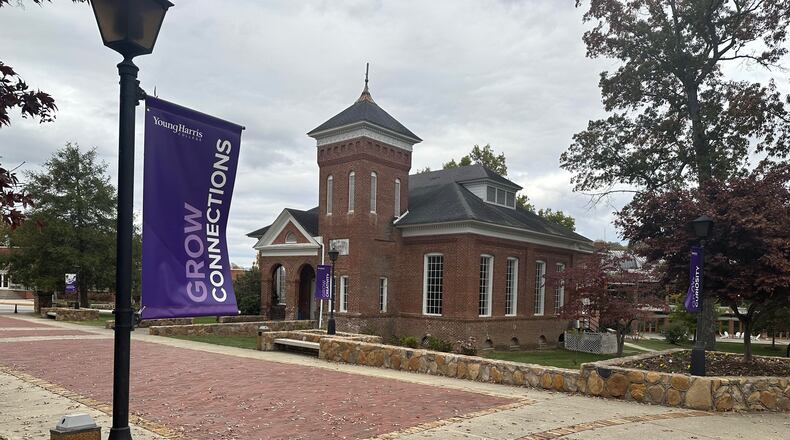YOUNG HARRIS — Zell Miller was a shy teenager when he enrolled in his small mountain town’s namesake college in 1945, too timid to speak on campus with returning World War II soldiers or students from bigger cities like Atlanta and Gainesville.
He went on to become Georgia’s governor and a U.S. senator. But these days he is most known for revolutionizing the state’s higher education system through the Helping Outstanding Pupils Educationally and Zell Miller scholarships.
On Friday, a bit more than six years after he died, a Georgia historical marker dedicated to the Georgia Lottery Corporation will be unveiled on the Young Harris College campus.
More than 2 million college students have been awarded over $15 billion in scholarship funds by the lottery and initiatives Miller pushed to establish in the 1990s. Lottery funds have also enabled more than 2 million children to attend prekindergarten programs.
Credit: Fletcher Page
Credit: Fletcher Page
Young Harris College, a private Methodist-affiliated liberal arts school, is nestled in a valley in the shadows of an Appalachian mountain ridgeline, with Brasstown Bald — the highest point in the state — hulking nine miles to the south and the North Carolina state line five miles to the north. Miller was born and raised here, often running barefoot during childhood and jumping into swimming holes named Blue Bend, Cupid’s Falls and Sycamore.
There are no photos of him in the college’s yearbook during his first few years. He later said he was too shy to have his picture taken.
At some point, he joined a debate club and took direction from an English teacher, Mrs. Edna Herron, who always wore a flower in her hair and expected perfection. Eventually, Miller found his voice, and he gained the confidence to take a stance. He developed a knack for convincing people his argument was on the right side.
Over the next six decades, the Young Harris native had campaign slogans like “Give ‘Em Hell, Zell,” broke from decades of Southern governors by pushing for legislation to nix the Confederate battle symbol from the state flag and had a famous confrontation with television talking head Chris Matthews during the 2004 presidential election cycle.
“More than bricks and mortar, it is a college where the individual still counts, an institution which strives to educate the total person,” Miller wrote in “The Mountains Within Me,” published in 1976.
During his first term as governor in the early 1990s, he helped launch the Helping Outstanding Pupils Educationally program, or HOPE. The scholarship and grant initiative provides financial aid to Georgia residents attending public and private colleges and universities throughout Georgia, as well as public technical colleges.
“Zell had carried the idea (for HOPE), bits and pieces of it, during his 16 years as lieutenant governor,” Shirley Miller, his widow, told The Atlanta Journal-Constitution this week.
It irked Zell, Shirley said, that many of the best high school students in Georgia left the state for college, according to Zell Miller’s survey of the school system in the 1980s. He figured that hurt the workforce talent in the state, with college graduates likely to get a job near where they attended school.
In fiscal year 1993-94, 42,796 students were HOPE recipients. Last year, the program awarded $841 million for aid to more than 178,000 Georgia students.
“We didn’t know how much money the lottery was going to bring in,” said Shirley Miller, who plans to attend the unveiling of the Georgia Historical Society marker on campus Friday.
Florida, Tennessee and South Carolina were among those that followed Georgia’s model. The program “has been emulated but never surpassed by other states,” former President Jimmy Carter said in 2018, when Miller died at the age of 86.
Enrollment at Young Harris College in 1951 was 254, according to the minutes of a college board of trustees meeting held in June of that year. The cost for tuition, board and fees per quarter: $150, or about $1,800 in today’s dollars.
Young Harris, the town, had a population of roughly 450 in ‘51. Shirley Miller, now 88, recalls small class sizes and teachers with high standards on campus: “It was a strict atmosphere.”
During her first quarter, she quickly made friends who were friends with Zell. The two hit it off where Zell was most comfortable, at a baseball game, in a nearby small town in western North Carolina.
“By the time we got to know each other, I think he was coming to the realization of how much more he wanted to know than what he did,” she said.
Credit: Fletcher Page
Credit: Fletcher Page
By 1951, Zell Miller was voted “Most Popular” in Young Harris College’s graduating class. He was captain of the baseball and basketball teams, editor of the school newspaper and yearbook and president of his fraternity. He went on to serve in the Marines, studied at the University of Georgia and Emory University and taught at UGA and Young Harris College.
He also served as city mayor of Young Harris, was elected to two terms as a state senator and was lieutenant governor from 1975 to 1991. He served as Georgia’s governor from 1991 to 1999 and was a U.S. senator from 2000 to 2005.
Today, the town of Young Harris has a population of more than 1,000. Bigger than before but still small.
The college has grown more quickly, with roughly 800 students on campus and a few hundred more enrolled in online classes. It transitioned from a junior college to a four-year institution in 2008.
Ian Warwick, a native of Elberton majoring in education, says the growth hasn’t robbed the campus of its tight-knit charm.
“I can’t walk to one of my classes without stopping to talk to somebody,” said Warwick, 22. “Everybody is family here, teachers and students both.”
Young Harris College also has roughly 400 HOPE Scholars. Warwick is one of them.
Credit: Fletcher Page
Credit: Fletcher Page
Warwick, like Zell Miller, grew up obsessed with baseball and wasn’t sure what he wanted to be when he grew up. He maintained a 3.2 grade-point average in high school, good enough to earn the scholarship, which he said pays roughly $2,500 per semester.
“I don’t have any student loans, and my family really helps out with that,” Warwick said. “HOPE has helped us so we don’t have to take out student loans.”
Also like Miller, Warwick has learned much about himself up in the mountains and on the campus. He says he has a 3.8 GPA, is president of his fraternity and student treasurer of the Georgia Association of Educators. He also tutors, works in the admissions office and gives campus tours. He plans to be a special-education teacher after graduation.
“I bloomed here,” Warwick said. “I really came out of my shell.”
About the Author
Keep Reading
The Latest
Featured






